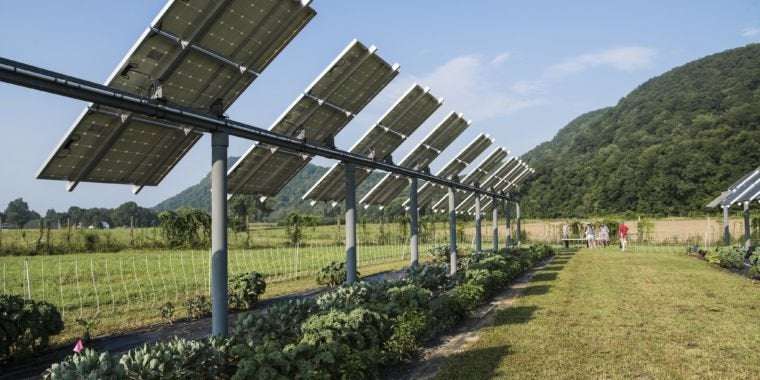Solar panels might seem like they’re in direct competition with plants. One is catching sunlight to do photosynthesis, the other wants to take it to push electrons. Surely Highlander rules apply, and there can be only one on a plot of land, right?
In reality, it’s not a zero-sum game. Some plants will burn in direct sun, after all, and so there are plenty of food crops that would be happy to share their space with panels. And as a new study led by the University of Arizona’s Greg Barron-Gafford shows, the combination isn’t even necessarily a compromise—there are some synergies that can bring significant benefits to a solar-agriculture.
Prof. Barron-Gafford et al. focused on dry areas like the American Southwest, where water for crops is limiting and things are projected to get drier. The shade provided by solar panels could lower soil surface temperatures and evaporation, the researchers thought, and vegetation could similarly keep the panels themselves a little cooler than a bare ground installation. Since solar panel efficiency drops at high temperature, that could mean more electricity generated.
To test this, the researchers set up three plots for the summer months: one only solar panels, one with only crops, and one with both. The solar panels, in this case, were built to stand a little over 3 meters off the ground—higher than a typical solar array. All three plots were irrigated the same, and temperatures, humidity, and soil moisture were tracked. Cherry tomatoes, jalapeños, and chiltepin peppers were chosen as the crops to test.
The results showed that combining things did alter temperatures, as expected. Air temperatures stayed a little over 1°C cooler during the day, on average, but they also stayed about 0.5°C warmer overnight. The temperature of the solar panels, though, was about 9°C cooler during the day because of the growth beneath them. The air was also a little less dry under the solar panels, and the soil dried out more slowly between waterings.
As for the crops, there were some significant differences. As the chiltepin peppers are shade-adapted, they were considerably happier with some solar panels overhead. Growth was calculated in terms of CO 2 uptake, and this was 33% higher in the combined plot. The water-use efficiency of the plants didn’t change, so they also used more soil moisture as they grew. The mass of peppers they produced, however, tripled under the solar panels.
The jalapeños, on the other hand, took up 11% less CO 2 under the panels, showing that they missed the extra sunlight. Even so, their water efficiency increased in a big way, and they used 65% less water. The amount of peppers produced dropped slightly, but not beyond the error bars.
Finally, the cherry tomatoes saw a 65% increase in CO 2 uptake and a 65% increase in water-use efficiency. They produced twice as much fruit while using the same amount of water.
Based on the temperature-efficiency curves of these solar panels, the researchers calculated that the cooler temperatures should increase electricity generation by about 3% over the summer months, averaging out to a 1% gain for the whole year.
The researchers see potential here (and in similar “agrivoltaics” experiments elsewhere) that is worth investigating and optimizing. Solar panel installations may not be compatible with the machinery used to harvest many crops, and boosting the panels higher off the ground costs extra. But there are configurations for certain crops in certain areas that can make a lot of sense. Farmers could save water, make money from a solar lease, and might even find that workers are much more comfortable and safe working under some shade—all while allowing solar arrays to expand in those areas without competing for land with agriculture.
Nature Sustainability, 2019. DOI: 10.1038/s41893-019-0364-5 (About DOIs).

TheOrangieOrange on September 6th, 2019 at 04:39 UTC »
My turn to shine! I research solar panels, specifically the degradation of modules. There have been many recent studies noting the importance of ground cover to the lifetime of the module. Solar farms with grass or foliage cover show less signs of degradation than ones with gravel. This is due to the albedo (reflected radiation) of the ground cover. Foliage has a much lower albedo than gravel so less radiation is reflected and less damage is observed.
Achylife on September 6th, 2019 at 04:01 UTC »
Ahhh complementary sciences. I love when there is a great way to combine two for maximum efficiency.
mvea on September 6th, 2019 at 03:10 UTC »
The title of the post is a copy and paste from the title, subtitle and eighth paragraph of the linked academic press release here:
Journal Reference:
Agrivoltaics provide mutual benefits across the food–energy–water nexus in drylands
Greg A. Barron-Gafford, Mitchell A. Pavao-Zuckerman, Rebecca L. Minor, Leland F. Sutter, Isaiah Barnett-Moreno, Daniel T. Blackett, Moses Thompson, Kirk Dimond, Andrea K. Gerlak, Gary P. Nabhan & Jordan E. Macknick
Nature Sustainability (2019)
Link: https://www.nature.com/articles/s41893-019-0364-5
DOI: https://doi.org/10.1038/s41893-019-0364-5
Abstract
The vulnerabilities of our food, energy and water systems to projected climatic change make building resilience in renewable energy and food production a fundamental challenge. We investigate a novel approach to solve this problem by creating a hybrid of colocated agriculture and solar photovoltaic (PV) infrastructure. We take an integrative approach—monitoring microclimatic conditions, PV panel temperature, soil moisture and irrigation water use, plant ecophysiological function and plant biomass production within this ‘agrivoltaics’ ecosystem and in traditional PV installations and agricultural settings to quantify trade-offs. We find that shading by the PV panels provides multiple additive and synergistic benefits, including reduced plant drought stress, greater food production and reduced PV panel heat stress. The results presented here provide a foundation and motivation for future explorations towards the resilience of food and energy systems under the future projected increased environmental stress involving heat and drought.